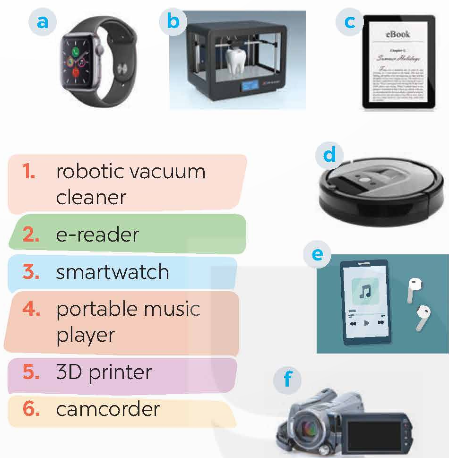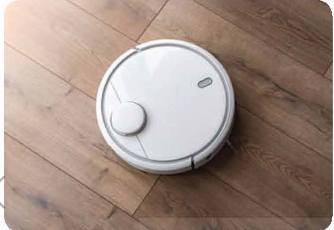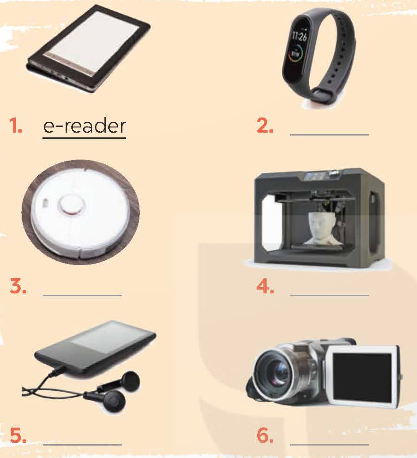Giải SGK, SBT Unit 11. World Englishes Global Success
Giải SGK, SBT Unit 11 Global Success
3. Match the following words with their definitions.
(Nối các từ sau với định nghĩa của chúng.)
|
1. aluminium |
a. a screen of a laptop or a tablet that enables the user to interact directly with what is displayed |
|
2. portable |
b. made to appear to exist by the use of computer software, rather than in the real world |
|
3. touchscreen |
c. not needing wires to make a connection or to communicate |
|
4. wireless |
d. a light, silver-grey metal |
|
5. virtual |
e. easy to carry or to move |
2. Complete the sentences with the material words from the box.
(Hoàn thành các câu với các từ ngữ quan trọng trong khung.)
|
rubber cardboard steel plastic copper |
1. We often use _______ which is a soft reddish-brown metal, to make electric wire, pipes, and coins.
2. Today, _______ is often used to make cases of electric devices because it doesn't conduct electricity and it is light, and easily be shaped into many different forms.
3. We often use _______ in the construction industry because it is a strong and hard metal.
4. We use _______, which comes from rubber trees, for making tyres, boots, etc.
5. The kids need a piece of _______ to easily cut shapes and make toys.
What do you call these materials in Vietnamese?
(Bạn gọi những vật liệu này trong tiếng Việt là gì?)
Electronic devices in modern classrooms
(Thiết bị điện tử trong lớp học hiện đại)
3. Read Nick's and Phong's ideas about the use of electronic devices in modern classrooms and tick (✔) T (True) or F (False).
(Đọc ý kiến của Nick và Phong về việc sử dụng thiết bị điện tử trong lớp học hiện đại và đánh dấu (✔) T (Đúng) hoặc F (Sai).)
Nick: Nowadays, electronic devices are becoming more and more popular in modern classrooms. Teachers can use electronic devices to teach interactive lessons, provide real-time feedback to students, etc. Students can use them to access online resources, cooperate with their classmates, and complete assignments online. Some schools use digital textbooks and educational software instead of traditional print materials.
Phong: There are some disadvantages of using electronic devices in modern classrooms. Students may become distracted by non-educational content such as social media or entertainment websites. Additionally, constant use of electronic devices may cause eye strain, headaches, and poor posture, as well as other health problems.
|
|
T |
F |
|
1. Nick says that electronic devices help students collaborate with their classmates. |
|
|
|
2. According to Nick, print materials have been replaced by digital textbooks and educational software in most schools. |
|
|
|
3. Phong says social media or entertainment websites help increase students' focus and attention during class time. |
|
|
|
4. According to Phong, prolonged use of electronic devices can lead to health problems. |
|
|
2. Read the following leaflets and match the highlighted words with their meanings.
You can do a lot of things with this small smartphone! This light, stylish phone has a special self-portrait feature that helps you send great photos of yourself right away. Its camcorder will record important moments, so you can share them with friends. Besides standard text messaging and phone calls, it can keep you connected through emails, video calls, and social networking apps.
This portable music player can carry your music collection everywhere you go and supply your favourite hits at your fingertips. Listen to up to 24 hours of high-quality music wherever you are - on the bus, in the car, or at the gym. The portable music player allows you to store up to 5,000 songs and even play games.
This smart window shade doesn't only help you control how much light comes into your house, but it also saves money by preventing heat or cold from entering our house. It's an excellent option for those that have trouble controlling the temperature of their houses. It can also give additional privacy to apartments by blocking out light as well as unwanted views.
|
Words |
Meanings |
|
1. stylish |
a. a piece of material fixed onto a roller that we can pull down to cover a window |
|
2. self-portrait |
b. fashionable; elegant and attractive |
|
3. window shade |
c. the state of being not watched or disturbed by other people |
|
4. privacy |
d. a picture or photograph that you make of yourself |
3. Read the leaflets again and tick T (True) or F (False).
(Đọc lại tờ rơi và đánh dấu T (Đúng) hoặc F (Sai).)
|
|
T |
F |
|
1. The smartphone allows you to connect with everybody through emails, video calls, and social networking apps. |
|
|
|
2. You can send the photographs of yourself immediately with the smartphone. |
|
|
|
3. The portable music player doesn't allow you to play games on it. |
|
|
|
4. You cannot control how much light comes into your house with the smart window shade. |
|
|
|
5. The smart window shade allows you to control the temperature of your house. |
|
|
2. Complete the sentences with the words from the box.
(Hoàn thành câu với các từ trong khung.)
|
3D printer copper plastic e-reader smartwatch |
1. We often use ________ to make power lines and electrical wires because it is a good conductor of electricity.
2. I can adjust the text size and font to suit my reading preferences on my ________.
3. My ________ can track my physical activity, heart rate, and sleep patterns, so it can help me monitor my overall health and fitness.
4. We often use ________ to make toys for children because it's durable, lightweight, and easy to mold into different shapes.
5. If I need a replacement part for a machine or device, I can use my ________ to create a new one that is a perfect fit.










